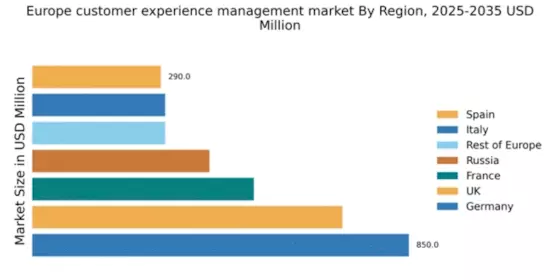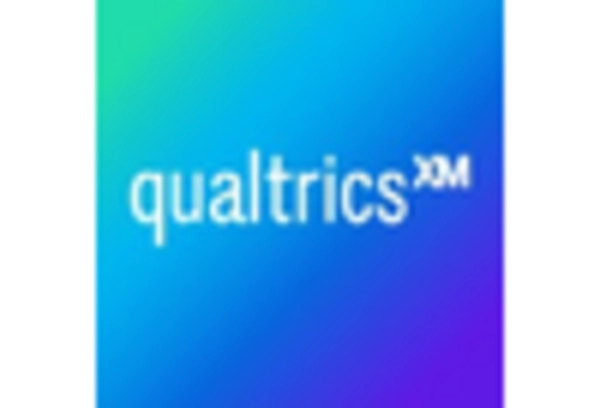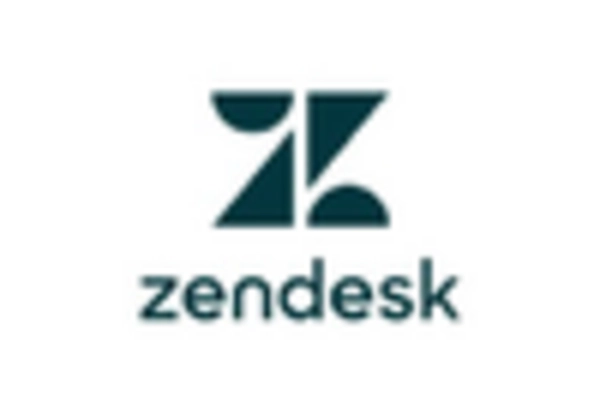Rising Consumer Expectations
The customer experience-management market in Europe is currently influenced by a notable rise in consumer expectations. As customers become increasingly discerning, they demand personalized and seamless interactions across various touchpoints. This shift compels businesses to invest in advanced customer experience strategies to meet these heightened expectations. According to recent data, approximately 70% of consumers in Europe express a preference for brands that offer tailored experiences. Consequently, organizations are prioritizing customer experience management solutions to enhance satisfaction and loyalty. This trend indicates a growing recognition of the importance of understanding customer needs and preferences, which is essential for success in the competitive landscape of the customer experience-management market.
Regulatory Compliance and Standards
The customer experience-management market in Europe is significantly impacted by regulatory compliance and standards. With the implementation of stringent data protection regulations, such as the General Data Protection Regulation (GDPR), businesses are compelled to adopt practices that ensure customer data privacy and security. This regulatory landscape necessitates the integration of compliance measures into customer experience strategies. Companies that prioritize adherence to these regulations not only mitigate risks but also build trust with their customers. As a result, the demand for customer experience-management solutions that incorporate compliance features is likely to rise, reflecting the growing importance of regulatory considerations in shaping customer interactions.
Shift Towards Sustainable Practices
The customer experience-management market in Europe is increasingly influenced by a shift towards sustainable practices. Consumers are becoming more environmentally conscious, prompting businesses to adopt sustainable strategies in their operations. Research indicates that approximately 60% of European consumers prefer brands that demonstrate a commitment to sustainability. This trend compels organizations to integrate sustainability into their customer experience management initiatives, thereby enhancing brand loyalty and reputation. By aligning their practices with consumer values, companies can differentiate themselves in a competitive market. This growing emphasis on sustainability suggests that the customer experience-management market will continue to evolve, reflecting the changing priorities of consumers.
Increased Focus on Customer Retention
In the current landscape, the customer experience-management market in Europe is witnessing an increased focus on customer retention strategies. Businesses recognize that retaining existing customers is often more cost-effective than acquiring new ones. Recent studies indicate that improving customer retention rates by just 5% can lead to an increase in profits of 25% to 95%. This realization drives organizations to invest in customer experience management solutions that foster loyalty and engagement. By prioritizing retention, companies can create long-term relationships with their customers, ultimately enhancing their competitive advantage in the market. This trend underscores the importance of understanding customer needs and delivering exceptional experiences.
Technological Advancements in CX Tools
Technological advancements are significantly shaping the customer experience-management market in Europe. The integration of innovative tools and platforms enables businesses to streamline their customer interactions and gather valuable insights. For instance, the adoption of cloud-based solutions has increased by over 40% in the past year, allowing companies to enhance their operational efficiency. Furthermore, the rise of analytics tools facilitates data-driven decision-making, which is crucial for optimizing customer journeys. As organizations increasingly leverage technology to improve their customer experience strategies, the demand for sophisticated customer experience-management solutions is expected to grow, reflecting the evolving landscape of consumer expectations.


















Leave a Comment